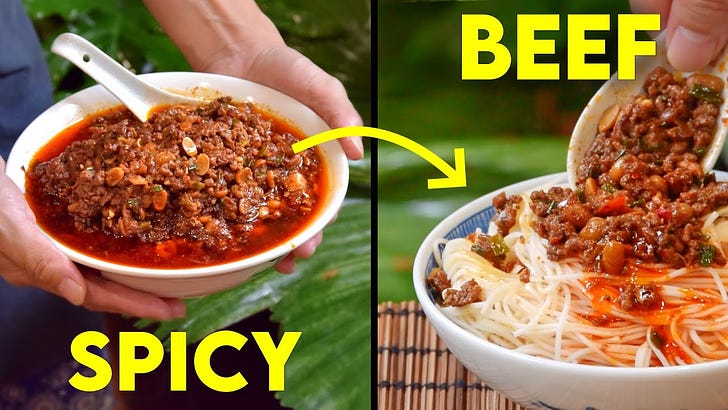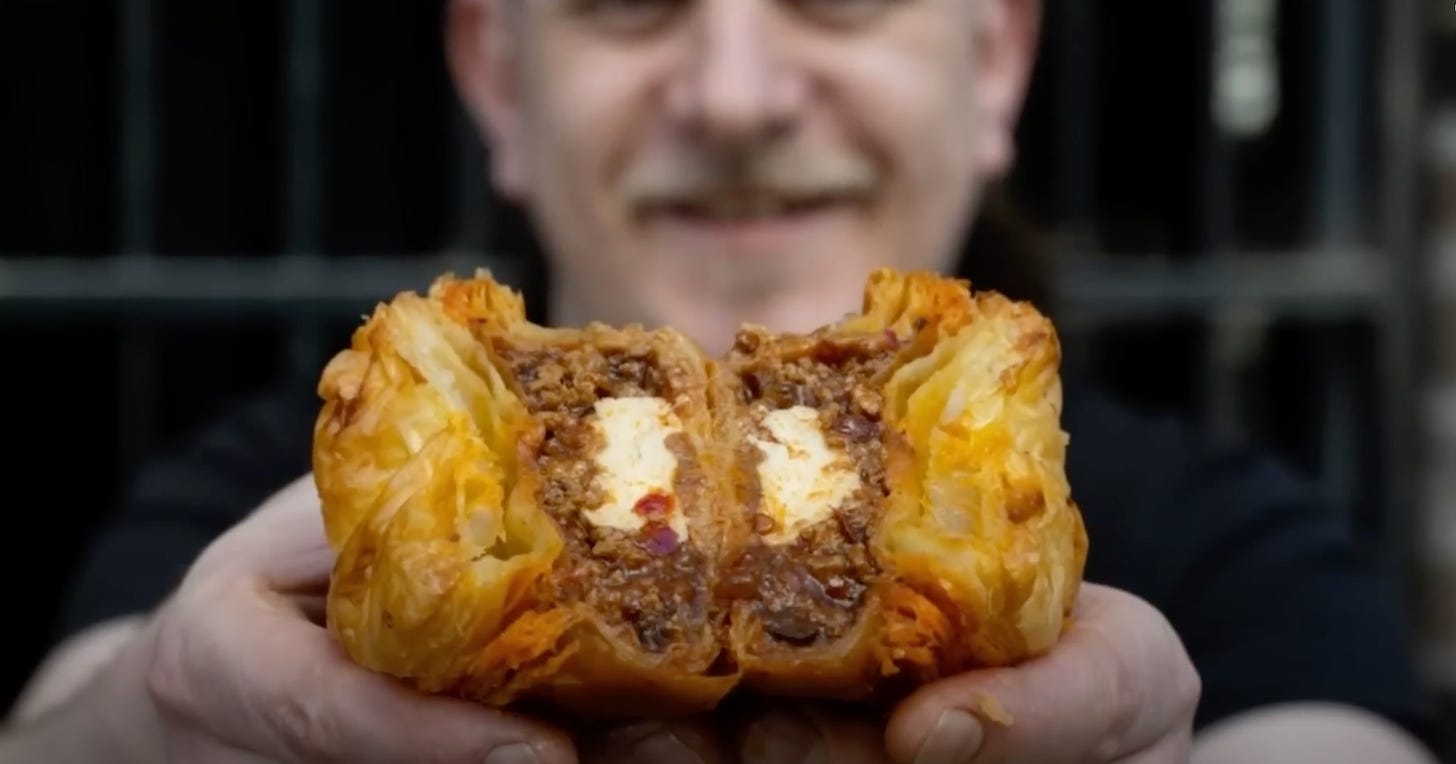Chinese Meat Sauce (香菇肉酱/麻辣肉酱)
Two Chinese meat sauces - a classic from Fujian, as well as a (slightly creative) Sichuan-inspired Mala sauce.
Click to jump to Fujian Pork and Mushroom sauce
Click to jump to Sichuan-inspired Mala beef sauce
Above is a bowl of Roujiang, Chinese meat sauce. It might not look like much, but it’s hyper flavorful… and ends up settling around the midpoint between a dish and a condiment – you can devour it straight (because why not) but roujiang really shines as an addition.
And it’s as an addition that it feels like a lot of people out there might actually be looking for without knowing it.
Don't Mapo-ify, Roujiang-ize!
So… we're all fans of Mapo Tofu, I'm pretty sure. It's spicy, saucy, numbing, and might just be the perfect gateway tofu. It's so much so that it feels like when people outside of China wanna try to get creative with Sichuan flavors, they seem to reach for “mapo tofu” as a base idea. I've seen mapo tofu chili dogs, mapo tofu nachos, mapo tofummus, mapo burgers… and apparently mapo tofu ramen is, like, a real thing in Japan?
Anyway, we're big proponents of all of this stuff - it's fun, - but from a culinary perspective we do have an ever so slight critique.
Because, for most of these concoctions, doesn't the tofu feel kinda… superfluous? Like, this mapo tofu meat pie looks pretty tasty but isn't the beef like completely drowning the tofu?
On some level, it feels like people don't actually want to Mapo Tofu-ify things – what they really want to add into their dish is some sort of delicious “mala beef slop”. So they reach for mapo tofu, the closest alternative, because… using some sort of “mala beef slop” as a sauce wouldn't actually be thing in China, right?
The culture of meat sauce in China
Enter again, our roujiangs. You see, in different pockets around the country, you can find a pretty rich tradition of these sorts of meat sauces. It's one of those things that can kind of be a part of the… family economy – you make a big batch, maybe jar it up, and use it to top rice, mix with noodles, have as a base for stir fries… whatever. It's a super homecooking sort of affair, so… often a less of an explicit 'dish' per se and more of a… 'confluence of ideas'.
So then, what we wanted to do here today was two things. First, we'll show you one of the few Chinese roujiangs that has been 'standardized' to the point of 'dishhood' – a much beloved pork and mushroom sauce from the Fujian province called xianggu roujiang.
And second? While there's actually not too much out there in the way of specifically 'mala' Chinese meat sauces, there are a metric ton of homestyle spicy meat sauces, so we also wanted to try to get a little creative and use some of those standard roujiang sensibilities to try to formulate a mapo-esque Chinese-style meat sauce.
Fujian Pork and Mushroom Meat Sauce
Dried shiitake mushroom (冬菇), 4
Oil for frying, preferably peanut, ~1/3 cup
Ground pork, 300g
Shallots (干葱), 60g
Sugar, 1 tbsp
Slab sugar (片糖) or dark brown sugar, 50g
Yellow bean sauce (黄豆酱), aka Taucho, 6 tbsp
Soy sauce (生抽), 2 tbsp
Sweet chili sauce (甜辣酱), 2 tbsp
Dark soy sauce (老抽), ¼ tsp
Chicken bouillon powder (鸡粉), 2 tsp
Five spice powder (五香粉), 1 tsp
Salt, ¼ tsp
Reserved mushroom soaking liquid, ~1/2 cup
Thoroughly rinse four shiitakes, then soak overnight in cool water. Next day, squeeze the mushrooms, slice out the stems, and dice.
Mince 60g of shallot. Combine all the remaining ingredients except the pork and the oil in a bowl and set aside.
Over a medium flame, swirl in a third of a cup of peanut oil. Add the pork and fry until it changes color. Add the shiitakes and the shallot. Fry for ~15-20 minutes, or until the pork has started to brown, and render out a bit of oil. Add the remaining ingredients, and cook for ~5 minutes or so to sort of ‘combine’ the flavors.
Mala Beef Sauce
For the following sauce, we will be using homemade Sichuan pepper powder as well as a homemade toasted chili powder. You can also use store bought powders but I would recommend the homemade route for the Sichuan pepper powder as it will give you a more numbing end result. But it’s totally up to you.
To make Sichuan pepper powder. For the peppercorns, toast one tablespoons worth over a medium-low flame for ~3 minutes, or until they begin to glisten and leave little oil splotches on your wok. Then grind in a mortar or spice grinder.
To make toasted Chili powder. For the chili powder, we’re using a mix of ~7.5g of spicy chilis (Xiaomila ‘millet’ chilis, but you could use Tien Tsin or Thai birds eye) and ~15g of a red, fragrant chili (Sichuan Erjingtiao ‘two vixen’ chili, but you could use Guajillo or Kashmiri). Slice up the chilis into your wok, discarding the stems, then toast over a medium-low flame. After ~10 minutes or so, the chilis should be brittle enough that you could break them apart with your fingers. Transfer to a spider or a colander, jiggle out most of the seeds. Grind into a powder.
Ingredients:
Soybeans (黄豆), 120g
Ingredients to cook the soybean:
Salt, ½ tbsp
Dried bay leaves (香叶), 2
Star anise (八角), 1
Chili pepper, 1
Sichuan peppercorns (花椒), ~7
Oil for frying, ⅔ cup
Spices to infuse the oil:
Cinnamon (桂皮), ~½ stick
Star anise (八角), 2
Fennel seed (小茴香), ½ tsp
Tsaoko a.k.a. Chinese black cardamon (草果), 1
Pixian doubanjiang a.k.a. chili bean paste (红油郫县豆瓣酱), 2.5 tbsp
Aromatics:
Garlic, 8 cloves. Minced.
Ginger, ~2 inches. Minced.
Onion, ½ medium. Minced.
Scallion, 150g. White and green parts separated and both sliced (greens are used later in the recipe)
Ground beef, 500g
Douchi, fermented black soybeans (豆豉), 1.5 tbsp. A.k.a. Yangjiang preserved beans
Chili powder from above -or- a mix of 2 tbsp cayenne pepper and 2 tbsp of a not spicy chili powder like gochugaru or Kashmiri. Feel free to use less cayenne/more mild chili if you want it less spicy.
Soybean cooking liquid, 1.5 cups
Liaojiu a.k.a. Shaoxing wine (料酒/绍酒), 1.5 tbsp
Soy sauce (生抽), 4 tbsp
Sugar, ½ tbsp
Chicken bouillon powder (鸡粉), 1 tsp
Final seasoning:
Salt, ¼ tsp
White pepper powder (白胡椒粉), 1 tsp
MSG (味精), 1 tsp
Dark Chinese vinegar (陈醋/香醋), ½ tbsp
Sichuan peppercorn powder from above -or- 1 tbsp
Process:
To prep:
Wash 120g of soybeans, then soak with hot, boiled water overnight – covered. The next day, drain, then add to a pot together with water and half tablespoon salt, two dried bay leaves, one star anise, one chili pepper, and seven Sichuan peppercorns. Bring up to a boil, then down to a simmer.
The length of time will depend on the age of the soybean. In the west, you will likely need to cook for 3-4 hours as the soybeans are generally older than in China (where one hour is often sufficient). Once soft, strain and reserve the soybean cooking liquid.
Mince eight cloves of garlic, a half a medium onion, and two inches of ginger. Take 150g of scallion and separate the white and the green. Slice both - keep the white part with the with the rest of the aromatics and the greens in a separate bowl (which we’ll use later in the recipe).
If you are opting for the toasted chili powder and Sichuan peppercorn from above, remember to prepare them before frying.
To fry:
Over a medium flame, swirl in ⅔ of a cup of oil. Add in a half a cinnamon stick, two star anise, a half teaspoon of fennel seed, and an optional but recommended caoguo, a.k.a. Chinese black cardamom. Let those slowly infuse into the oil until fragrant, about eight minutes or so, then remove and shut off the heat.
Then, toss in two and a half tablespoons of Pixian doubanjiang, chili bean paste, and fry that over a low flame. Once its stained the oil obviously red, about three minutes or so, go in with your minced aromatics. Fry your aromatics until they're fragrant and basically cooked through, about three minutes or so, then swap the flame to high and go in with a half kilo of beef and a tablespoon half of douchi, Chinese fermented black soybeans.
Once your beef is looking good and cooked, toss in your chili powders (either the homemade toasted chili powder, or the mix of 2 tbsp each spicy and non-spicy chili powder). Fry that together for about a minute, then toss in one and a half cups of your reserved soybean cooking liquid, a tablespoon and a half of liaojiu a.k.a. Shaoxing wine, four tablespoons of soy sauce, a half tablespoon of sugar, and a teaspoon of chicken bouillon powder. Give that all a good mix, then go in with your cooked soybeans… and let that continue to cook and reduce over a high flame.
After about eight minutes or so, the liquid should be mostly evaporated away, and you should be able to hear things kinda frying instead of bubbling. Once you're there, toss in the scallion greens, and let those fry until cooked, about one minute.
Then, finish off the seasoning with a quarter teaspoon salt, one teaspoon of white pepper powder, a teaspoon of MSG, a half tablespoon of dark Chinese vinegar, and the Sichuan peppercorn powder.




